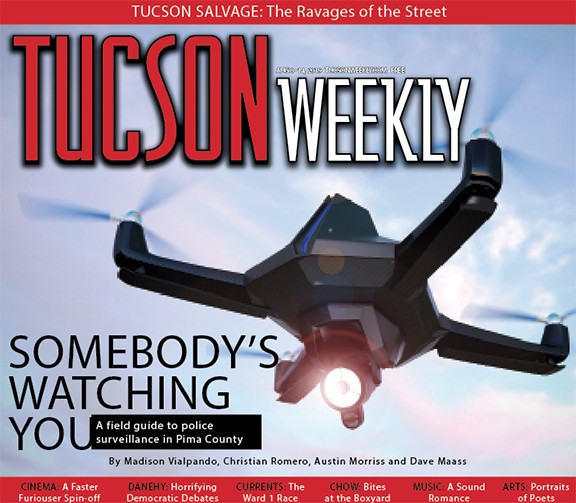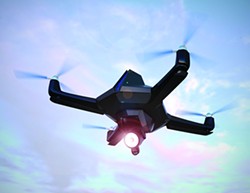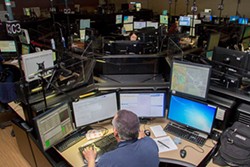When law enforcement and tech companies talk about surveillance equipment, they often use the term "force multiplier." This buzzword is meant to alleviate fears that machines will reduce the number of cops on the beat and instead emphasize the idea that technology will expand the reach of police so they can solve more crimes with fewer resources. But with crime rates both locally and nationally on a downward trajectory, it remains an open question whether cops actually need to be force-multiplied or they're just dazzled by new devices and software platforms.
These discussions often happen behind the scenes with little public input or awareness, with government officials marveling at the near-miraculous capabilities of the products extolled by salespeople without exploring the negative consequences. Cops don't usually ask what's the worst that can happen if the technology fails or is abused, and it's even more rare for them to consider the potential long-term impact on society.
The Electronic Frontier Foundation (EFF), a non-profit that advocates for civil liberties in the digital age, partnered up with the University of Nevada, Reno's Reynolds School of Journalism to begin an inventory of what technologies law enforcement agencies have acquired. We have started with communities along the U.S.-Mexico border: areas of contention and controversy, where discussions of "virtual walls" have resulted in increased funding and focus on surveillance.
Law enforcement in Pima County deploy a variety of surveillance technologies, including drones, automated license plate readers, and body-worn cameras. The Tucson Police Department engages in predictive policing and pattern recognition through a real-time crime analytical center and an artificial intelligence system for analyzing data. The federal government also keeps a close eye on the border region with technologies on the ground and in the sky.
Some jurisdictions have responded well to the public's privacy concerns. For example, the Tucson Police Department is one of the few metropolitan areas that does not track license plates and it no longer uses its "Stingray," a controversial cell-phone tracking technology.
This primer on Pima County surveillance aims to strike a balance between what police know about us and what the public knows about police. For more information about these technologies, visit EFF's Street-Level Surveillance hub at eff.org/sls.
TRACC and COPLINK
The Tucson Police Department operates the Tucson Real-Time Analytical Crime Center (TRACC), a technology center staffed around the clock by law enforcement officers and at least six analysts. In addition to accessing law enforcement databases, TRACC staff monitor calls for service and live video feeds. The TRACC unit provides predictive analyses of criminal activity and traffic incidents, that "go beyond simple collection and disbursement of statistics and provide more detailed analyses of the motivations behind criminal activity," according to a profile in Police Chief magazine.
"A key goal of TRACC is to provide officers who are responding to calls with as much information as possible about potential suspects at the scene (including their criminal histories), prior interactions with the occupants at—or previous calls for service to—a particular address, and other analytical data that may help officers avoid unnecessary risk, be more effective in their responses, and solve crimes," Tucson Police Chief Chris Magnus wrote in a Facebook post on the department's "21st Century Policing" goals.
The Tucson Police Department also partnered with the University of Arizona Artificial Intelligence Lab to develop COPLINK,a software system that uses artificial intelligence algorithms to mine and analyze records across multiple law enforcement databases. According to the Tucson Police website, “The core software enables police officers to instantly uncover associations between people, locations, vehicles, weapons, and organizations in ways that were previously time and resource prohibitive.” COPLINK is also shared with other agencies in Arizona, including 19 police departments in the Phoenix metropolitan area. Body-Worn Cameras Body-worn cameras (BWC) are small devices affixed to an officer’s uniform that capture video and audio of the officer’s encounters with the public. Often billed as a measure to enhance police accountability, BWCs also function as a mobile surveillance network.
The Tucson Police Department outfits its officers with BWCs to gather video and audio information during interactions with the public, including emergency calls, stops, and arrests. As of January 2019, Tucson police had more than 500 BWCs and was seeking funding for 129 more devices. Tucson Police Department uses two types of Axon BWCs. One version of the camera is the Axon Flex, which has a camera that connects to a pair of glasses, with a wire that connects to a battery that attaches to an officer’s shirt. The second camera is the Axon Body, which is a single one-piece camera that attaches to an officer’s shirt.
According to the Pima County Attorney, BWCs are also used by the Sahuarita Police Department (49 BWCs), the Marana Police Department (60 cameras), the Oro Valley Police Department (65 BWCs), and the University of Arizona Police Department (56 BWCs). The South Tucson Police Department received funding from the Tohono O’Odham Nation to purchase BWCs for all its officers in 2015.
Body-worn cameras (BWC) are small devices affixed to an officer’s uniform that capture video and audio of the officer’s encounters with the public. Often billed as a measure to enhance police accountability, BWCs also function as a mobile surveillance network.
The Tucson Police Department outfits its officers with BWCs to gather video and audio information during interactions with the public, including emergency calls, stops, and arrests. As of January 2019, Tucson police had more than 500 BWCs and was seeking funding for 129 more devices.
Tucson Police Department uses two types of Axon BWCs. One version of the camera is the Axon Flex, which has a camera that connects to a pair of glasses, with a wire that connects to a battery that attaches to an officer’s shirt. The second camera is the Axon Body, which is a single one-piece camera that attaches to an officer’s shirt.
According to the Pima County Attorney, BWCs are also used by the Sahuarita Police Department (49 BWCs), the Marana Police Department (60 cameras), the Oro Valley Police Department (65 BWCs), and the University of Arizona Police Department (56 BWCs). The South Tucson Police Department received funding from the Tohono O’Odham Nation to purchase BWCs for all its officers in 2015.
Automated License Plate Readers
Automated license plate readers (ALPRs) are networks of cameras used to track the movements of vehicles. Police attach cameras to patrol cars or fixed locations, like highway overpasses, to amass a searchable database that can reveal a driver’s movement. Police may also add license plates to a “hot list” to get real-time alerts whenever the vehicle is photographed by an ALPR.
The Oro Valley Police Department’s policy authorizes officers to use ALPR for a wide variety of investigations, including identifying stolen or wanted vehicles, stolen license plates, missing persons, active warrants, surveillance, suspect interdiction, stolen property recovery, and for undefined “homeland security” activities. Police are also encouraged to canvass neighborhoods around crime scenes using vehicles outfitted with ALPRs. Oro Valley Police volunteers also drive cars equipped with ALPR technology.
In 2019, the Marana Police Department acquired an ALPR system, along with vehicle-mounted thermal imaging cameras through Operation Stonegarden, a federal grant program to encourage collaboration between local law enforcement and immigration authorities. The Pima County Sheriff’s Department applied for a similar Operation Stonegarden grant in 2019, however the Pima County Board of Supervisors rejected the line item for ALPR technology. The sheriff does however have access to ALPR data collected by other entities through a contract with Vigilant Solutions. The U.S. Drug Enforcement Administration also has automated license plate readers along Interstate 19 and Arizona State Route 86, according to the Arizona Daily Star. U.S. Customs and Border Protection affixes ALPR cameras to its vehicles and installs concealed cameras for limited periods during investigations and along “smuggling routes.”
Drones
Drones are remote-controlled vehicles that police use for aerial surveillance. Local agencies generally use compact, less expensive drones known as small unmanned aerial systems (sUAS) or quadrotors, as opposed to the larger systems deployed by the military and the Department of Homeland Security. With the purchase of two quadrotors In 2016 Sahuarita Police Department became the first local law enforcement agency in Arizona to deploy drones. The wide variety of authorized uses include public safety missions, such as searching for lost or missing people or suspects at large, monitoring emergency situations, and documenting crime scenes, but the drones may also be used for creating marketing materials for the town. However, SPD told the Sahuarita Sun that the drones will not be used “in tactical situations, such as when someone is barricaded or officers serve high-risk search warrants.”
Shortly after Sahuarita’s purchase, Oro Valley Police Department purchased three drones from Chinese manufacturer DJI. Pima County Sheriff’s Department also purchased two drones in 2019. According KGUN 9, the primary use will be to document traffic accident scenes, but the drones may also be used to support SWAT operations. However, KGUN reports, “they are not going to use it for any sort of general day-to-day surveillance.”
Camera Registration
The Tucson Police Department maintains a database of security cameras owned by private citizens using the website CrimeReports. Residents voluntarily provide information about both indoor and outdoor cameras. According to KOLD, “If a crime was to happen in the area around a home or office, TPD officers might reach out to owners to see if they can review the video to help them solve the crime.” Residents are also able to provide law enforcement with login credentials for cameras that are connected to the Internet.
Face Recognition
The Arizona Department of Transportation uses face recognition technology on the state’s driver’s license database, primarily as a fraud prevention measure. Local agencies and federal do not have direct access to this system, but may request ADOT conduct searches on its behalf.
Federal Surveillance Technologies
In addition to ALPRs, the U.S. Customs and Border Protection monitors the border using large MQ-9 Predator B drones and surveillance blimps called aerostats. These Tethered Aerostat Radar Systems (TARS) watch over the southern border at 10,000 feet and can detect all flying aircraft within 200 miles of the blimp.
Throughout the border region, CBP has installed surveillance structures called Integrated Fixed Tower systems (IFTs) that include electro-optical and infrared sensors, video cameras and radar systems that transmit back to workstations at border patrol centers. CBP ran into resistance from the Tohono O’odham Nation with placement of IFTs on their land. However, according to the Arizona Daily Star, Tohono O’odham officials approved 10 IFTs in March 2019.
This project is a collaboration between the Electronic Frontier Foundation and the Reynolds School of Journalism at the University of Nevada, Reno. Zoe Wheatcroft and Tiffany Jing also contributed to this report. It is available for reuse under a Creative Commons Attribution (CC BY) license.






